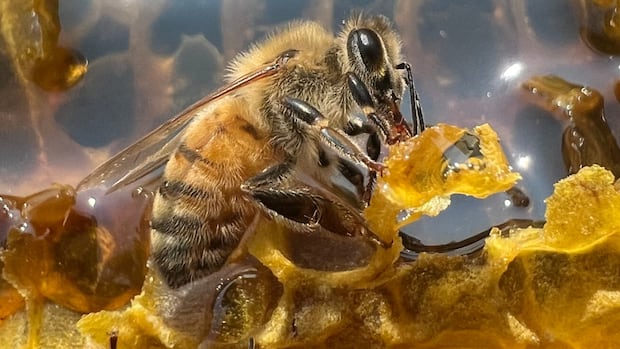Ancient tool discovered in Saskatoon strawberry patch highlights city’s rich archaeological history
It’s a fist-sized piece of granite that speaks to the history hidden beneath the paved streets and manicured yards in Saskatoon.
“That is a very lovely, classic example of a grooved maul. It’s got the nice groove going all the way around; it’s got some wear on its end. So it’s been used, definitely,” said Karin Steuber with the Saskatchewan Archaeological Society.
“It probably would have been hafted [attached] to a handle and would have been used as a hammer.”
This particular tool turned up in a strawberry patch in a south Saskatoon neighbourhood earlier this month. Steuber said the find is typical of what’s just beneath the surface of gardens, yards and parks around the city.
“The entirety of Saskatoon is covered in archaeological sites,” said Steuber.
“As the city has built up and grown outwards over the years, every time they put up a development they may come across some remnant of a site used by Indigenous groups.”
This grooved maul turned up in the Nutana Park neighbourhood, not far from Market Mall.
That area is just north of Stonebridge, a subdivision that was developed in the 1990s but that has an archaeological history that goes back decades.
A fist-sized piece of granite pulled from a strawberry patch speaks to the history hidden beneath the paved streets and manicured yards in Saskatoon.
Members of the Saskatoon Archaeological Society began work on the area in the 1960s. It proved to be a rich repository of stone tools, projectile points and pottery, as Indigenous people had killed and processed buffalo there for centuries.
Stantec Consulting Ltd. has worked on archaeological assessments of the neighbourhood, identifying 11 distinct sites in Stonebridge — nine that were there before contact with European settlers.
Lauren Stead from Stantec researched the area around Chief Whitecap School in 2017. She said it’s not difficult to imagine what a person in that area would have seen, thousands of years ago.

“Similar to what you would see south of the city now, without the agriculture,” she said.
“What we call native grasslands. Lots of different types of grasses, and pockets of bush and trees that you would see south of the city now.”
Marshy, low areas proved attractive to hunters because bison would get bogged down and be easier to kill.
Stead examined the grooved maul and was struck by its weight, density and the clear amount of work that went into it.
“This would be somebody’s treasured possession. A lot of work went into making it so it would have travelled with them. These aren’t things that you sit down and make in 15 minutes and use and discard.”
Steuber said it’s difficult to precisely date this grooved maul because it wasn’t discovered alongside a “diagnostic artifact” with a specific shape and size.
“We know that definitely people would have been using this [type of tool] for over 10,000 years, whether it’s 200 years old or 10,000 years old,” she said.
“And it probably would have been used through time, too. Somebody could have made this 8,000 years ago, left it behind, and then 3,000 years later somebody picked it up and continued to use it as well.”





